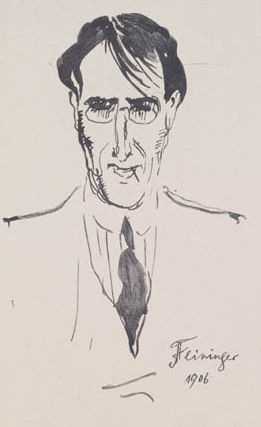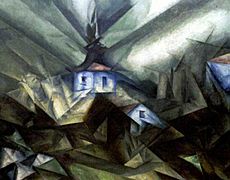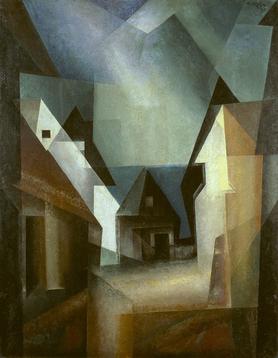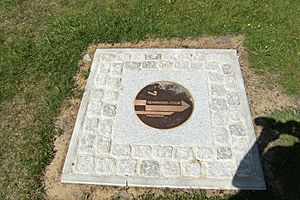Lyonel Feininger facts for kids
Quick facts for kids
Lyonel Feininger
|
|
|---|---|

Lyonel Feininger by Emil Orlik, 1906
|
|
| Born | July 17, 1871 New York City, New York, U.S.
|
| Died | January 13, 1956 (aged 84) New York City, New York, U.S.
|
| Nationality | German-American |
| Known for | Painting, Cartoonist, Photography |
| Movement | Expressionism, Cubism, Blaue Reiter, Die Brücke, Berlin Secession, Novembergruppe |
| Elected | American Academy of Arts and Letters (1955) |
Lyonel Charles Feininger (born July 17, 1871 – died January 13, 1956) was a talented German-American artist. He was a leading painter in a style called Expressionism. He also drew caricatures and comic strips. Feininger was born and grew up in New York City. When he was 16, he moved to Germany to study art.
He became a successful cartoonist in 1894. For 20 years, he drew funny pictures for newspapers and magazines in the USA and Germany. At age 36, he began creating fine art. He also took many photos between 1928 and the mid-1950s. He mostly shared these photos with friends. Feininger was also a musician, playing piano and composing music.
Contents
Life as an Artist
Lyonel Feininger was born to musical parents. His father, Karl Feininger, was a violinist and composer. His mother, Elizabeth Feininger, was a singer. Lyonel grew up in New York City. In 1887, at age 16, he moved to Germany to study art.
In 1888, he moved to Berlin. He studied at the Königliche Akademie Berlin. He also studied at other art schools in Berlin and Paris.
Starting as a Cartoonist
Feininger began his career as a cartoonist in 1894. He worked for many magazines in Germany, France, and America. In 1906, a newspaper called Chicago Tribune hired him. He created two comic strips for them: "The Kin-der-Kids" and "Wee Willie Winkie's World". These comics were known for their funny humor and interesting drawings.
He worked as a commercial caricaturist for 20 years. He drew for various newspapers and magazines in both the United States and Germany. Later, a famous comic artist, Art Spiegelman, praised Feininger's comics. He said they had amazing artistic grace.
Becoming a Fine Artist
Feininger started creating fine art when he was 36 years old. He joined important art groups in Germany. These included the Berliner Sezession and German expressionist groups. Some of these groups were Die Brücke, the Novembergruppe, and the Blaue Reiter circle.
His first solo art show was in Berlin in 1917. In 1919, Walter Gropius started the Bauhaus art school in Germany. Feininger was the first artist Gropius hired to teach there. He became the master artist in charge of the printmaking workshop.
From 1909 to 1918, Feininger spent his summer breaks on the island of Usedom. He found new ideas and inspiration there. Many of his paintings from this time show scenes from the Baltic Sea coast. He continued to draw and paint scenes from Benz for the rest of his life. Even after moving back to the United States, he remembered these places. Today, there's a special tour on Usedom. It guides visitors to the spots that appear in Feininger's artworks.
He designed the cover for the Bauhaus school's first manifesto in 1919. It was an expressionist woodcut of a 'cathedral'. He taught at the Bauhaus for several years. Some of his students became artists themselves.
Challenges and Return to America
When the Nazi Party came to power in Germany in 1933, things became difficult for Feininger. The Nazi Party called his art "degenerate." This meant they thought his art was bad and harmful. His work was even shown in a special "degenerate art" exhibition in 1936.
Because of this, he and his wife moved to America. He taught at Mills College before returning to New York City. In 1955, he was chosen to be part of the American Academy of Arts and Letters.
Other Artistic Pursuits
Besides drawing and painting, Feininger also created art using toy figures. He would photograph these figures in front of drawn backgrounds.
He took many photos between 1928 and the mid-1950s. He was 58 years old when he started photography. His neighbor in Dessau was a famous photographer, László Moholy-Nagy, who encouraged him. Feininger mostly kept his photos private. He shared them with friends like Walter Gropius.
Feininger also played piano and composed music. He wrote several piano pieces and organ fugues. In 2011, an orchestra performed some of his orchestral music. Feininger always said that the composer Bach was his "master in painting."
Lyonel Feininger passed away on January 13, 1956. He was buried in New York. His sons, Andreas Feininger and T. Lux Feininger, also became famous artists. Andreas was a photographer, and T. Lux was a photographer and painter.
Major Art Exhibitions
A big exhibition of Lyonel Feininger's art was held in 2011-2012. It started at the Whitney Museum of American Art in New York. Then it moved to the Montreal Museum of Fine Arts. This show was special because it was the first time in over 45 years that his art was shown in his home country. It also included all types of his artwork.
Another important exhibition of Feininger's photographs took place in Germany and the USA in 2011-2012. It traveled to cities like Berlin, Munich, Los Angeles, and Cambridge, Massachusetts.
Art Sales
Feininger's paintings have sold for high prices at auctions.
- In 2001, his painting The Green Bridge (1909) sold for about £2.42 million (around $3.5 million at the time).
- In 2007, his oil painting "Jesuits III" (1915) sold for $23.28 million.
- In 2017, his oil painting Fin de séance (1910) sold for $5.63 million.
Selected Works
- 1907, Der weiße Mann, (Collection Museo Carmen Thyssen-Bornemisza, Madrid)
- 1910, Straße im Dämmern, (Sprengel Museum, Hannover)
- 1913, Gelmeroda I, (Private collection, New York)
- 1913, Leuchtbake, (Museum Folkwang, Essen, Germany)
- 1916, Grüne Brücke II (Green Bridge II), (North Carolina Museum of Art, Raleigh)
- 1918, Teltow II, (Neue Nationalgalerie, Berlin)
- 1918, "Yellow Streets II", (Musée des Beaux-Arts de Montréal, Montréal)
- 1920, Ostsee-Segelboote II, (Private collection, Wichita, KS)
- 1922, Church of Heiligenhafen, (Reynolda House Museum of American Art, Winston-Salem, NC)
- 1925, Barfüßerkirche in Erfurt I, (Staatsgalerie Stuttgart)
- 1926, Barfüßerkirche II (Church of the Minorities II)
- 1929, Halle, Am Trödel, (Bauhaus-Archive, Berlin)
- 1931, Die Türme über der Stadt (Halle), (Museum Ludwig, Köln)
- 1936, Gelmeroda XIII, (Metropolitan Museum of Art, New York)
- 1940, The River, (Worcester Art Museum, MA)
See also
 In Spanish: Lyonel Feininger para niños
In Spanish: Lyonel Feininger para niños




